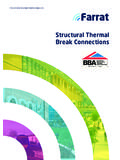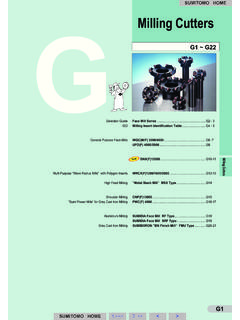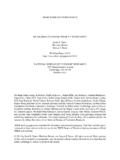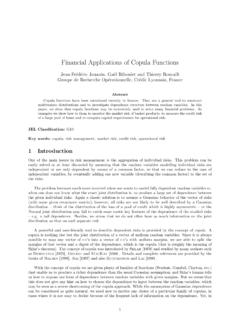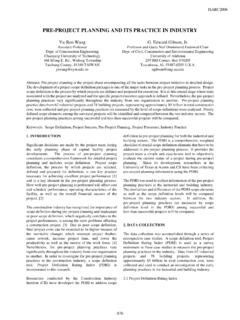Transcription of LTC4357 - Positive High Voltage Ideal Diode Controller
1 LTC4357 4357fdFeaturesapplicationsDescriptionPos itive High VoltageIdeal Diode ControllerThe LTC 4357 is a Positive high Voltage Ideal Diode control-ler that drives an external N-channel MOSFET to replace a Schottky Diode . When used in Diode -OR and high current Diode applications, the LTC4357 reduces power consump-tion, heat dissipation, Voltage loss and PC board LTC4357 easily ORs power sources to increase total system reliability. In Diode -OR applications, the LTC4357 controls the forward Voltage drop across the MOSFET to ensure smooth current transfer from one path to the other without oscillation. If the power source fails or is shorted, a fast turn-off minimizes reverse current , 10A Diode -ORn Reduces Power Dissipation by Replacing a Power Schottky Diode with an N-Channel MOSFETn s Turn-Off Time Limits Peak Fault Currentn Wide Operating Voltage Range: 9V to 80Vn Smooth Switchover without Oscillationn No Reverse DC Currentn Available in 6-Lead (2mm 3mm) DFN and 8-Lead MSOP Packagesn N + 1 Redundant Power Suppliesn High Availability Systemsn AdvancedTCA Systemsn Telecom Infrastructuren Automotive Systems4357 TA01 LTC4357 GNDINOUTVDDGATEFDB3632 VINA48 VVOUT TO LOADLTC4357 GNDINOUTVDDGATEFDB3632 VINB48V*SEE FIGURES 2 AND 3 FOR ADDITIONAL OPTIONAL COMPONENTSP ower Dissipation vs Load Currenttypical applicationCURRENT (A)00 POWER DISSIPATION (W)12345624684357 TA01b10 Diode (MBR10100)FET (FDB3632)POWERSAVEDL, LT, LTC, LTM, Linear Technology and the Linear logo are registered trademarks and Hot Swap is a trademark of Linear Technology Corporation.
2 All other trademarks are the property of their respective 4357fdabsolute MaxiMuM ratingsSupply Voltages IN .. 1V to 100V OUT, VDD .. to 100 VOutput Voltage GATE (Note 3) ..VIN to VIN + 10V(Notes 1, 2)TOP VIEWVDDNCGNDOUTINGATEDCB PACKAGE6-LEAD (2mm s 3mm) PLASTIC DFN457 GND6321 TJMAX = 125 C, JA = 90 C/W EXPOSED PAD (PIN 7) PCB GND CONNECTION OPTIONAL1234 INNCNCGATE8765 OUTVDDNCGNDTOP VIEWMS8 PACKAGE8-LEAD PLASTIC MSOP TJMAX = 125 C, JA = 163 C/WOperating Ambient Temperature Range LTC4357C ..0 C to 70 C 40 C to 85 C LTC4357H .. 40 C to 125 C LTC4357MP .. 55 C to 125 CStorage Temperature Range .. 65 C to 150 CLead Temperature (Soldering, 10 sec) MS Package ..300 Cpin conFigurationorDer in ForMationLEAD FREE FINISH TAPE AND REEL (MINI)TAPE AND REELPART MARKING*PACKAGE DESCRIPTIONTEMPERATURE RANGELTC4357 CDCB#TRMPBFLTC4357 CDCB#TRPBFLCXF6-Lead (2mm 3mm) Plastic DFN0 C to 70 CLTC4357 IDCB#TRMPBFLTC4357 IDCB#TRPBFLCXF6-Lead (2mm 3mm) Plastic DFN 40 C to 85 CLTC4357 HDCB#TRMPBFLTC4357 HDCB#TRPBFLCXF6-Lead (2mm 3mm) Plastic DFN 40 C to 125 CTRM = 500 pieces.
3 *Temperature grades are identified by a label on the shipping LTC Marketing for parts specified with wider operating temperature ranges. Consult LTC Marketing for information on lead based finish more information on lead free part marking, go to: For more information on tape and reel specifications, go to: FREE FINISHTAPE AND REELPART MARKING*PACKAGE DESCRIPTIONTEMPERATURE RANGELTC4357 CMS8#PBFLTC4357 CMS8#TRPBFLTCXD8-Lead Plastic MSOP0 C to 70 CLTC4357 IMS8#PBFLTC4357 IMS8#TRPBFLTCXD8-Lead Plastic MSOP 40 C to 85 CLTC4357 HMS8#PBFLTC4357 HMS8#TRPBFLTCXD8-Lead Plastic MSOP 40 C to 125 CLTC4357 MPMS8#PBFLTC4357 MPMS8#TRPBFLTFWZ8-Lead Plastic MSOP 55 C to 125 CLEAD BASED FINISHTAPE AND REELPART MARKING*PACKAGE DESCRIPTIONTEMPERATURE RANGELTC4357 MPMS8 LTC4357 MPMS8#TRLTFWZ8-Lead Plastic MSOP 55 C to 125 CLTC4357 4357fdelectrical characteristicsNote 1: Stresses beyond those listed under Absolute Maximum Ratings may cause permanent damage to the device.
4 Exposure to any Absolute Maximum Rating condition for extended periods may affect device reliability and lifetime. The l denotes the specifications which apply over the full operating temperature range, otherwise specifications are at TA = 25 C. VOUT = VDD, VDD = 9V to 80V unless otherwise Supply Rangel980 VIDDS upply Pin CurrentVIN = VOUT 1Vl150350500 AIOUTOUT Pin CurrentVIN = VOUT 1Vl80210 ADVGATEE xternal N-Channel Gate Drive (VGATE VIN)VDD, VOUT = 20V to 80V VDD, VOUT = 9V to 20Vl l10 615 15V VIGATE(UP)External N-Channel Gate Pull-Up CurrentVGATE = VIN, VIN VOUT = 14 20 26 AIGATE(DOWN)External N-Channel Gate Pull-Down Current in Fault ConditionVGATE = VIN + 5Vl12 AtOFFGate Turn-Off TimeVIN VOUT = 55mV | 1V, VGATE VIN < 1V, CGATE = 0pFl300500nsDVSDS ource-Drain Regulation Voltage (VIN VOUT)VGATE VIN = 2: All currents into pins are Positive , all voltages are referenced to GND unless otherwise 3: An internal clamp limits the GATE pin to a minimum of 10V above IN or 100V above GND.
5 Driving this pin to voltages beyond this clamp may damage the per ForMance characteristicsVDD Current (IDD vs VDD)IN Current (IIN vs VIN)OUT Current (IOUT vs VOUT)VDD (V)0 IDD ( A)400600804357 G012000204060800 VDD = VOUT = VIN 1 VVIN (V)0 IIN ( A)200300804357 G021000204060400 VDD = VOUT = VIN + 1 VVDD = VOUT = VIN 1 VVOUT (V)0 IOUT ( A)60120804357 G0302040601803090150 VDD = VOUT= VIN + 1 VVDD = VOUT= VIN 1 VLTC4357 4357fdtypical per ForMance characteristicsOUT Current (IOUT vs VIN)FET Turn-Off Time vs GATE CapacitanceFET Turn-Off Time vs Initial OverdriveGATE Current vs Forward Drop (IGATE vs DVSD)DVGATE vs GATE Current (DVGATE vs IGATE)VSD (mV) 50 50 IGATE ( A) 250250504357 G04100150$VGATE = ( A)00$VGATE (V)5101551015204357 G0525 VIN > 18 VVIN = 12 VVIN = 9 VVIN (V)0 IOUT ( A)75100125610144357 G065025024812 VOUT = 12V, VIN= VDDVINITIAL (V)0tPD (ns) 48V$VSD = VINITIAL 1 VFET Turn-Off Time vs Final OverdriveVFINAL (V) 1tPD (ns)10001500 G095000 48V$VSD = 55mV VFINALFET Load Current vs DVSDCGATE (nF)0tOFF (ns)300400500804357 G072001000204060 VGATE < VIN+ 1V$VSD = 55mV 1V VSD (mV)0 LOAD CURRENT (A)6810754357 G104202550 VIN= 48V WITH FET (FDB3632) LTC4357 4357fdpin FunctionsExposed Pad: Exposed pad may be left open or connected to : Gate Drive Output.
6 The GATE pin pulls high, enhanc-ing the N-channel MOSFET when the load current creates more than 25mV of Voltage drop across the MOSFET. When the load current is small, the gate is actively driven to maintain 25mV across the MOSFET. If reverse current develops more than 25mV of Voltage drop across the MOSFET, a fast pull-down circuit quickly connects the GATE pin to the IN pin, turning off the : Device : Input Voltage and GATE Fast Pull-Down Return. IN is the anode of the Ideal Diode and connects to the source of the N-channel MOSFET. The Voltage sensed at this pin is used to control the source-drain Voltage across the MOSFET. The GATE fast pull-down current is returned through the IN pin. Connect this pin as close as possible to the MOSFET : No Connection. Not internally : Drain Voltage Sense. OUT is the cathode of the Ideal Diode and the common output when multiple LTC4357s are configured as an Ideal Diode -OR.
7 It connects to the drain of the N-channel MOSFET. The Voltage sensed at this pin is used to control the source-drain Voltage across the : Positive Supply Input. The LTC4357 is powered from the VDD pin. Connect this pin to OUT either directly or through an RC hold-up BDCHARGE PUMP + ++ FPDCOMPGATEAMP25mV25mVINGATE17 VOUTGNDINVDD+ block DiagraMLTC4357 4357fdoperationHigh availability systems often employ parallel-connected power supplies or battery feeds to achieve redundancy and enhance system reliability. ORing diodes have been a popular means of connecting these supplies at the point of load. The disadvantage of this approach is the forward Voltage drop and resulting efficiency loss. This drop reduces the available supply Voltage and dissipates significant power. Using an N-channel MOSFET to replace a Schottky Diode reduces the power dissipation and eliminates the need for costly heat sinks or large thermal layouts in high power LTC4357 controls an external N-channel MOSFET to form an Ideal Diode .
8 The Voltage across the source and drain is monitored by the IN and OUT pins, and the GATE pin drives the MOSFET to control its operation. In effect the MOSFET source and drain serve as the anode and cathode of an Ideal power-up, the load current initially flows through the body Diode of the MOSFET. The resulting high forward Voltage is detected at the IN and OUT pins, and the LTC4357 drives the GATE pin to servo the forward drop to 25mV. If the load current causes more than 25mV of Voltage drop when the MOSFET gate is driven fully on, the forward Voltage is equal to RDS(ON) the load current is reduced causing the forward drop to fall below 25mV, the MOSFET gate is driven lower by a weak pull-down in an attempt to maintain the drop at 25mV. If the load current reverses and the Voltage across IN to OUT is more negative than 25mV the LTC4357 responds by pulling the MOSFET gate low with a strong the event of a power supply failure, such as if the output of a fully loaded supply is suddenly shorted to ground, reverse current temporarily flows through the MOSFET that is on.
9 This current is sourced from any load capacitance and from the other supplies. The LTC4357 quickly responds to this condition turning off the MOSFET in about 500ns, thus minimizing the disturbance to the output SelectionThe LTC4357 drives an N-channel MOSFET to conduct the load current. The important features of the MOSFET are on-resistance, RDS(ON), the maximum drain-source Voltage , VDSS, and the gate threshold Voltage . Gate drive is compatible with logic-level MOSFETs in low Voltage applications (VDD = 9V to 20V). At higher voltages (VDD = 20V to 80V) standard 10V threshold MOS-FETs may be used. An internal clamp limits the gate drive to 15V between the GATE and IN pins. An external Zener clamp may be added between GATE and IN for MOSFETs with a VGS(MAX) of less than maximum allowable drain-source Voltage , BVDSS, must be higher than the power supply Voltage . If an input is connected to GND, the full supply Voltage will appear across the MOSFET.
10 ORing Two-Supply OutputsWhere LTC4357s are used to combine the outputs of two power supplies, the supply with the highest output Voltage sources most or all of the load current. If this supply s output is quickly shorted to ground while delivering load current, the flow of current temporarily reverses and flows backwards through the LTC4357 s MOSFET. When the reverse current produces a Voltage drop across the MOSFET of more than 25mV, the LTC4357 s fast pull-down activates and quickly turns off the the other, initially lower, supply was not delivering load current at the time of the fault, the output falls until the body Diode of its ORing MOSFET conducts. Meanwhile, the LTC4357 charges its MOSFET gate with 20 A until the forward drop is reduced to 25mV. If instead this supply was delivering load current at the time of the fault, its associ-ated ORing MOSFET was already driven at least partially on, and the LTC4357 will simply drive the MOSFET gate harder in an effort to maintain a drop of inForMationLTC4357 4357fdapplications inForMationFigure 1.











